In fight against COVID-19, Germany donates 163 000 COVID-19 vaccine doses to Somalia through COVAX Facility
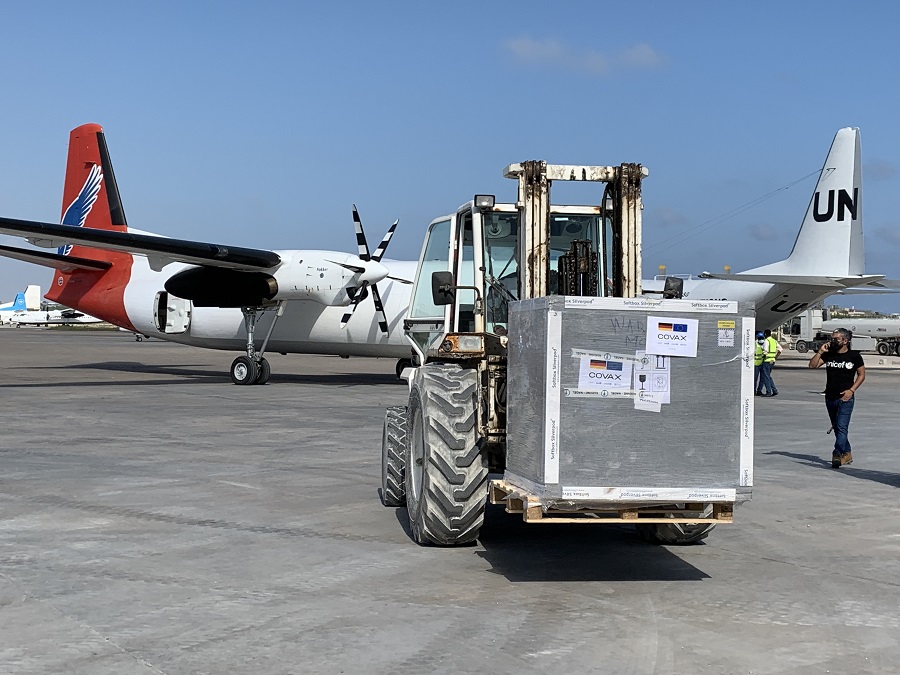 Photo: UNICEF/Hinds
Photo: UNICEF/Hinds
Mogadishu, 26 October 2021 – Somalia is scaling up its battle to combat the COVID-19 pandemic after receiving 163 000 doses of Oxford/AstraZeneca vaccines from the Government of Germany through the COVAX Facility today.
“The Government of Germany has extended its valuable support to Somalia in the fight against COVID-19 and we would like to thank them for this,” said Dr Fawziya Abikar Nur, the Minister of Health and Human Services of Somalia. “So far, 1.85% of our population has been fully vaccinated against COVID-19. With the support from Germany, we can ramp up our efforts to ensure more Somalis have access to the life-saving vaccines. It is only when we join forces that we become strong enough to stamp out diseases, like COVID-19, from Somalia and the rest of the countries all over the world.”
“We stand firmly with Somalia to protect its people against COVID-19,” said Sascha Kienzle, Deputy Ambassador to Somalia. “As the second largest donor to the global response to COVID-19, and one of the co-founders of the ACT-A, a distribution platform for COVID-19 vaccines, we understand the importance of ensuring safe and equitable access to these vaccines for every country to end this pandemic and to ensure vaccine equity. I hope our support will enable Somalia to immunize more of its citizens, giving them an opportunity to lead healthy lives and contribute to the country’s economy and development goals.”
In August 2021, the Government of Germany donated around 1.3 million face masks to WHO for Somalis to use and stay safe from COVID-19 and other infectious respiratory diseases.
“Donors, such as the Government of Germany, are playing an important role in the response plan for COVID-19. Together with the Federal Government of Somalia and UNICEF, WHO is supporting the vaccination drive to improve the uptake and use all means to reach every eligible Somali to receive a vaccine against COVID-19,” said Dr Mamunur Rahman Malik, WHO Representative to Somalia.
“Immunization is an effective intervention to halt the spread of COVID-19 and the dose donations, through the COVAX Facility, play an important role in enhancing equitable and safe access to the vaccines in Somalia. UNICEF is grateful to the Government of Germany and remains steadfast in its commitment to support the Ministry of Health in managing the cold chain systems to deliver the vaccines safely and in deploying community mobilizers to encourage the uptake of the vaccine,” said UNICEF Somalia Representative, Mohamed Ayoya.
Besides frontline workers, people aged over 50 and those with pre-existing medical conditions continue to be prioritized for vaccination. Somalia is also offering vaccines to all people aged 18 years and above.
When vaccines are prioritized for essential workers and people who are at highest risk of COVID-19 complications, health and other essential services will continue to function and deaths can be prevented. Unless health workers and other essential workers are protected, health systems and other essential services will remain overwhelmed, and the most vulnerable populations, including children, will continue to lose access to life-saving services, risking years of progress being reversed.
As of 25 October 2021, 652 886 doses have been administered in the country. So far, 289 925 (1.85%) people have been fully vaccinated against COVID-19 and 362 961 (2.32%) have been partially vaccinated.
Since the COVID-19 outbreak began in March 2020, Somalia has reported 21 998 laboratory-confirmed cases of COVID-19, including 1208 deaths, as of 25 October 2021.
For additional information, please contact:
Khadar Hussein Mohamud
Head of Coordination and Communication
Federal Ministry of Health and Human Services
Somalia
+252 615 602 637
Judith Gosmann
Policy Officer, Somalia Unit
Embassy of the Federal Republic of Germany to Somalia
+254 758 726 179
Fouzia Bano
WHO Chief of Staff ai, Communications Officer
+252 619 235 880
Eva Hinds
UNICEF Communication Manager
+252 613 642 635
Note to editors
Please see the link below for more information on the face masks donated by the Government of Germany to Somalia:
WHO EMRO | Germany donates 1.3 million face masks to WHO for its COVID-19 response work in Somalia: more face masks means more people protected | News | Somalia site
The COVAX Facility is a partnership between the Coalition for Epidemic Preparedness Innovations (CEPI), Gavi, the Vaccine Alliance, the United Nations Children’s Fund (UNICEF) and the World Health Organization (WHO). The facility aims to provide vaccines for at least 20% of countries’ populations.
More information on the COVAX Facility and the ACT-A Accelerator
Somalia rolls out FETP-Frontline training programme to build disease detectives and prevent spread of diseases
25 October 2021 – Having a public health workforce that is able to rapidly detect and respond to disease outbreaks is key for any health system, as recently shown on a worldwide scale with the current COVID-19 pandemic. The importance of this empowered and well-equipped resource is further emphasized by the International Health Regulations (IHR 2005), a legal instrument that encourages countries to prevent, detect and respond appropriately to disease outbreaks.
Taking measures to empower health workforce
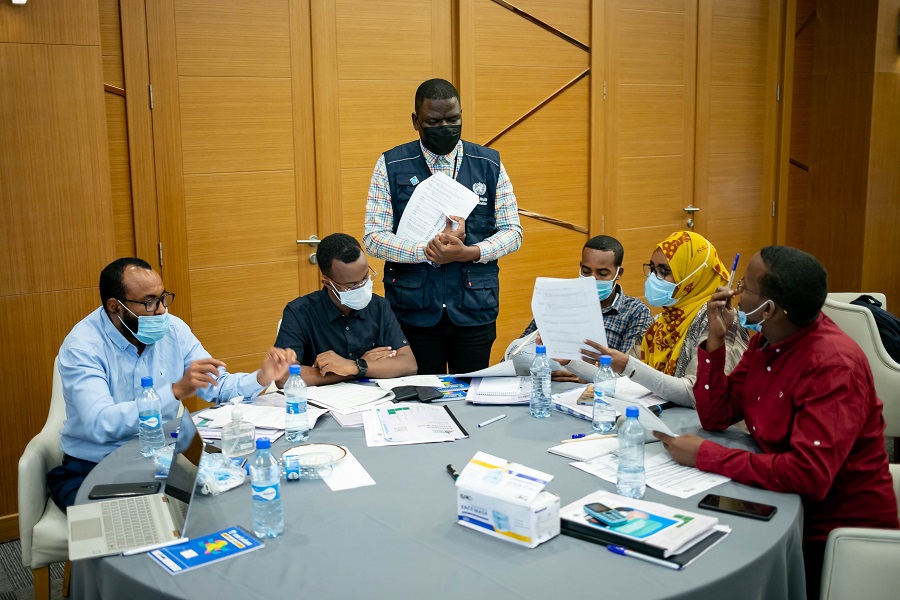 A WHO staff member facilitating a group discussion during the first training workshop for the first cohort of the FETP-Frontline programme
A WHO staff member facilitating a group discussion during the first training workshop for the first cohort of the FETP-Frontline programme
To address Somalia’s limited capacity in disease surveillance and response, largely a result of decades of political instability, civil unrest, climatic shocks, and manmade and health emergencies, the Somalia National Institute of Health (NIH) and the Federal Ministry of Health and Human Services organized the Frontline-Field Epidemiology Training Programme (FETP-Frontline), with support from the Africa Field Epidemiology Network (AFENET), the United States Centers for Disease Control and Prevention (US CDC), the World Health Organization (WHO) and the Public Health Agency of Sweden.
The FETP-Frontline is a 3-month on-the-job training that addresses the critical skills needed to conduct surveillance and response activities effectively at the local level, focusing on improving disease detection, reporting and response. It is based on the premise that improving the epidemiological skills of staff from the Ministry of Health improves their ability to prevent, detect and respond to public health priority issues, which in turn would improve public health security in a country. It aims to improve field epidemiology knowledge, skills and competencies of trainees, and blends mentorship with classroom training and practical experiences to develop the public health workforce of a country. The trainees spend up to 12 days in 3 workshops and the remaining 8–10 weeks back at their jobs, where they conduct field projects to practise, implement and reinforce what they have learned.
The FETP-Frontline is part of a 3-tiered training model which is implemented in many countries based on the recognition that strengthening the capacity of the public health workforce, especially in countries with fragile, vulnerable and conflict-affected countries, is critical at all levels of the health system, from the local to the regional to the national level. All 3 tiers use the same approach of condensed classroom instruction (<25%, followed by field placements >75%) to gain experience and competence in field epidemiology. The other 2 tiers of this training model are called the FETP-Intermediate (9-month programme for staff based at regional or national level) and FETP-Advanced (2-year full time programme for staff at national level).
Rolling out the first phase of the FETP training
The NIH kickstarted the 12-week long FETP-Frontline training programme with a first workshop, conducted from 29 August to 2 September 2021 for 26 participants, followed by practical field experience, and a second training workshop that ran from 6 to 12 October 2021.
Dignitaries attending the launch of the FETP training on 29 August included Dr Abdinasir Mukhtar Ibrahim, the Director-General of the Federal Ministry of Health and Human Services; Dr Mamunur Rahman Malik, the WHO Representative to Somalia; representatives from the Intergovernmental Authority on Development (IGAD) Mission; and Dr Abdifatah Diriye Ahmed, the Director of the NIH for Somalia. Others who attended included the technical team from AFENET.
The first of 3 tiers of training, the initial phase focused on training health workers at the frontlines of public health surveillance.
 Participants at the Somalia Frontline Field Epidemiology Training Programme
Participants at the Somalia Frontline Field Epidemiology Training Programme
Streamlining reporting through field experiences
Adan Mohamed Ali, who serves the National Malaria Control Programme run by the Federal Ministry of Health of Somalia, was one of the first 26 participants to attend this preliminary FETP training.
He explains that during the first phase of the 5-day classroom learning, he learnt a lot about disease surveillance, monitoring and evaluation, descriptive epidemiology and case investigation. As part of the on-the-job training, which comprises 75% of each training, Adan visited health facilities in the district of Kahda, Banadir region. The second set of training focused on presenting the results, outbreak investigation and response, laboratory collection and transport, problem analysis and communication.
“While conducting the audit, I was supposed to visit 6 health facilities. However, only 2 were still functioning and one was reporting to the Early Warning Alert and Response Network (EWARN). I tried to convince the facilities that were not reporting to do so, and help in the search for diseases, which would help the Government to prevent spread of diseases in communities,” explains Aden. “Through the field exercise, I learnt to identify gaps and challenges of disease surveillance and response in health facilities. I studied records for epidemiological weeks 1-36 for this year by reviewing log books, tally sheets, charts and graphs and interviewed health facility staff on reporting disease alerts, timeliness of reporting and discussed challenges the staff face in timely reporting of alerts.”
He added that efforts like this were important as they would help the country’s health system to streamline reporting of alerts and surveillance for epidemic-prone diseases.
Upon completion of the 3-month FETP-Frontline training programme, Adan and other successful trainees will move on to the intermediate and later advanced level courses, while at the same time becoming trainers for the next cohort.
Impact of the FETP
The evaluation of the first series of trainings shows an encouraging improvement in trainees’ knowledge, which is now being applied in their daily work. This programme will increase the capacity of Somalia’s health workforce in disease surveillance and outbreak response at all levels of service delivery. Moreover, the training will develop the capacity of trainees and health facilities to detect and respond to disease outbreaks in a timely manner and minimize the spread of diseases to contain them. Trainees will also gain skills to communicate risk to the public and design messages that will support policy- and decision-makers to implement effective public health responses.
“The WHO country office for Somalia is fully committed to continue working alongside the NIH, the CDC and AFENET to roll out the next steps of the FETP programme in Somalia, which will bring the country closer to bridging the current gap in number of epidemiologists per 100 000 population in Somalia and build a strong cadre of disease detectives in line with the requirements of the IHR 2005,” said Dr Mamunur Rahman Malik, WHO Representative to Somalia.
“The Frontline-FETP is one of the outcomes of the strong collaboration between the Federal Ministry of Health and our health development partners in addressing the most critical challenges of our health system, which is human resources for health,” said Dr Abdifatah Diriye Ahmed, NIH Director.
The WHO’s work in supporting the country’s FETP-Frontline training programme in Somalia is supported by the Swedish International Development Cooperation Agency (SIDA) and the work reflects WHO’s strong collaboration with its partner- The Public Health Agency of Sweden to promote and support the activities of the NIH.
World Polio Day 2021: Delivering on the promise to protect every Somali child from polio
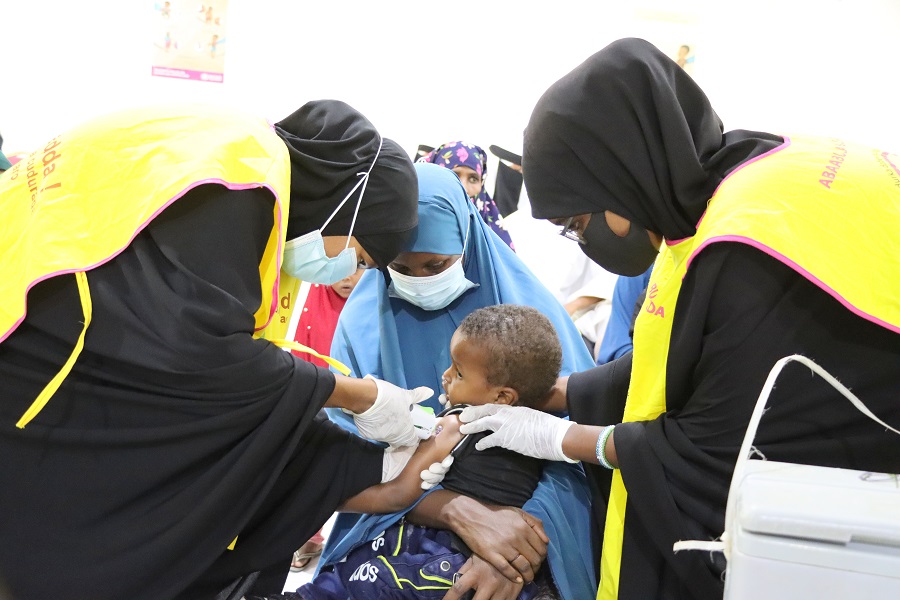
Mogadishu, 24 October 2021 – On World Polio Day 2021, the Federal Government of Somalia, World Health Organization (WHO), United Nations Children’s Fund (UNICEF) and other key partners from the Global Polio Eradication Initiative (GPEI) renewed their efforts to deliver on the promise to protect every Somali child from polio.
Over the years, Somalia has made substantial progress in polio eradication. The country stopped the transmission of wild poliovirus in 2013 and prevented its subsequent importations. However, outbreaks of other strains of poliovirus still pose a threat to unvaccinated children.
In March 2021, after 28 months, Somalia’s polio programme and partners successfully stopped an outbreak of a rare strain of circulating poliovirus type 3 (cVDPV3). Currently, an outbreak of circulating poliovirus type 2 (cVDPV2), detected for the first time in Somalia in the environment in November 2017 and in a child on 11 May 2018, continues to threaten under-vaccinated children. So far, 23 children have been infected, with the last reported case detected in October 2021.
Somalia’s polio programme is foundational to the health care system of the country and is a critical asset for disease surveillance and primary health care. With an extensive network of over 149 national and subnational polio health workers, present in every district across the country, the programme has provided immediate, urgent support to other outbreaks and public health emergencies.
With a vision to strengthen Somalia’s health systems while optimizing existing resources, the country is rolling out a polio transition plan capitalizing on the existing network of health workers to support other priority health care functions and streamline health service delivery. These efforts will ensure the country makes progress towards universal health coverage.
Tapping into new, rigorously tested innovations to respond to and prevent polio outbreaks swiftly and robustly, Somalia is at the forefront of countries to qualify for the use of a next-generation polio vaccine – known as novel oral polio vaccine (nOPV2). This vaccine protects children, particularly under-immunized ones, from the emergence of polio strains, as is genetically more stable than the monovalent oral polio vaccine (mOPV2), which is why it is being used as the “vaccine of choice” to address cVDPV2 outbreaks. Somalia is ready to use nOPV2 vaccines as soon as they are made available, which would be a significant development for polio eradication efforts.
In September 2021, the polio eradication programme in Somalia introduced fractional-dose inactivated polio vaccines (fIPV) in 5 districts, reaching a total of 80 916 children under the age of 5. This pilot project was another innovative milestone for the country, particularly as a fraction of this vaccine offers a specific kind of immunity that is similar to one full dose of inactivated polio vaccine (IPV) in children previously immunized with oral polio vaccine (OPV). The use of fIPV is critical in responding to an outbreak such as the one in Somalia.
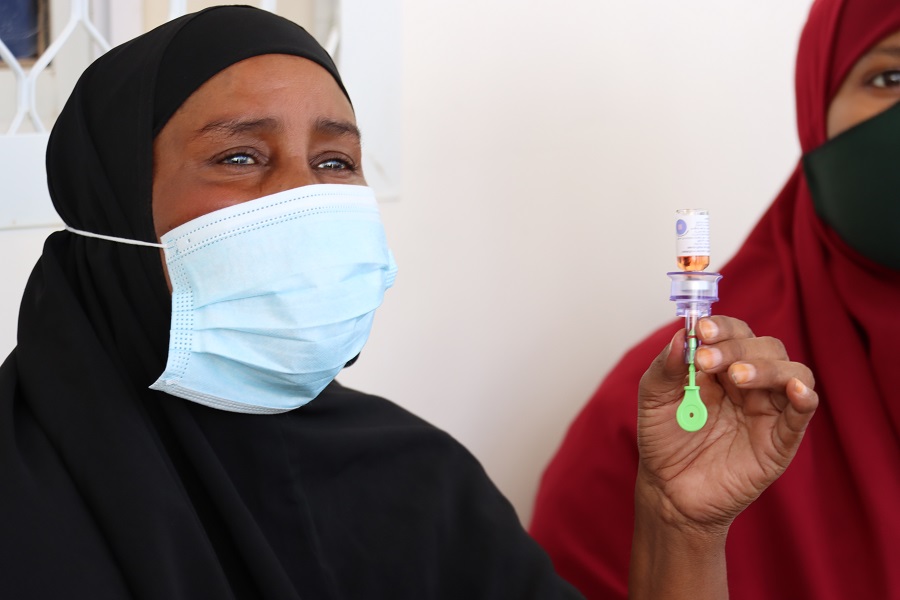
“We have come very far in the fight against polio,” said Dr Fawziya Abikar Nur, Minister of Health and Human Services, Somalia. “Despite this progress, we still need to ensure threats such as COVID-19 and any future pandemics and emergencies, and other logistical challenges do not reverse any gains made by the polio eradication initiative. On World Polio Day, we are taking this opportunity to renew our promise to every Somali child, to do all we can to keep them free from polio.”
Since the COVID-19 pandemic began, Somalia has conducted 2 nationwide and 7 subnational door-to-door polio campaigns, typically targeting around 3 258 352 children under the age of 5 per campaign across the country, and 3 small-scale campaigns to target children living in high-risk hotspots.
“WHO remains committed in its resolve to protect Somali children from polio and other vaccine-preventable diseases,” said Dr Mamunur Rahman Malik, WHO Representative to Somalia. “Every milestone we have witnessed so far, including the new ones such as the introduction of a new, powerful polio vaccines, has years of planning, research and collaboration, coupled with the unwavering support from donors, dedication of health workers and conviction of communities and caregivers behind it. We would like to thank each one of our stakeholders for their commitment.”
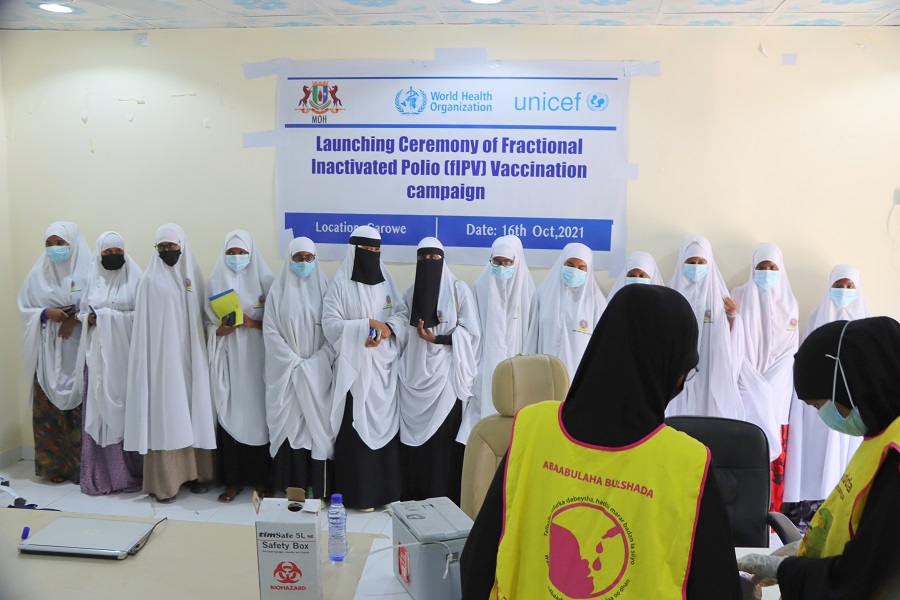
“Since the first national campaigns in 1997, a lot has been achieved to save Somali children from preventable paralysis of poliomyelitis,” said UNICEF Representative Mohamed Ayoya. “However, large numbers of children in Somalia do not receive immunization and other necessary health services. On this World Polio Day, we must commit ourselves to ensuring that polio no longer poses a threat to Somali children. No child should be left behind.”
For additional information, please contact:
Khadar Hussein Mohamud
Head of Coordination and Communication
Federal Ministry of Health
Fouzia Bano
WHO Chief of Staff ai, Communications Officer
+252 619 235 880
Eva Hinds
UNICEF Communication Manager
+252 613 642 635
Notes to editor:
For more information on novel oral polio vaccine (nOPV2), kindly see: nOPV2 – GPEI (polioeradication.org)
Additional information on the fractional dose IPV can be found here: Fractional dose IPV shown effective to stop outbreaks – GPEI (polioeradication.org).
The pilot project on fractional dose IPV in Somalia can guide national decision-making on the use of this vaccine in the country, as a scale-up of fIPV can be incorporated into routine immunization programmes to make the most of IPV stocks available, in view of the global shortage of IPV, and to increase immunization coverage of IPV in Somalia.
Somalia pioneers implementation of an integrated disease surveillance and response strategy in a fragile setting
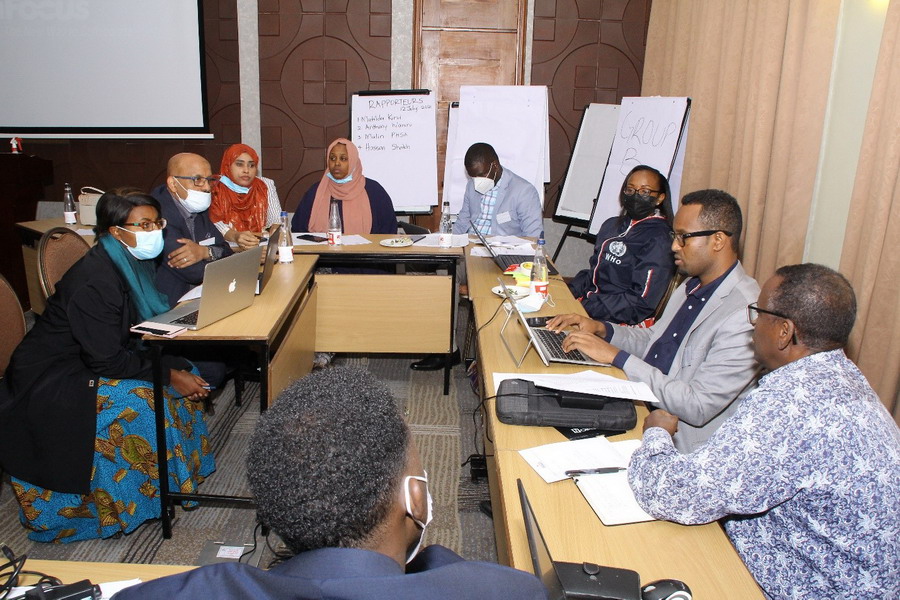 Participants at the IDSRS workshop formed groups to discuss topics such as the importance of focused disease surveillance in the context of the health challenges facing Somalia
Participants at the IDSRS workshop formed groups to discuss topics such as the importance of focused disease surveillance in the context of the health challenges facing Somalia
Why Somalia needed to implement the integrated disease surveillance and response strategy
As the COVID-19 pandemic has shown, the world is becoming a smaller place and travel across borders is becoming more accessible to growing populations, and the spread of diseases has become faster and more efficient. The pandemic has also shown that an outbreak in one country can quickly become a pandemic everywhere if the country’s capacity for early detection and effective response is weak. This has made it imperative for countries to prevent the spread of diseases both in-country and across borders, and for countries to act with speed and at scale each time an outbreak occurs in the interests of national and global public health.
Somalia has limited capacity to prevent, detect and respond to disease outbreaks and other acute public health events. This was demonstrated in 2018 by an International Health Regulations (IHR, 2005) assessment. The country’s current IHR capacity and health emergency preparedness index (a measure of IHR core capacity) is 31 out of 100 (at level 1 out of a maximum level 5), meaning that large gaps exist in the core capacities required to prevent, detect and comprehensively respond to public health threats.
Through sustained high-level efforts, led by the Somalia National Institute of Health of the Somalia Federal Ministry of Health, and supported by WHO, Somalia has adopted an integrated disease surveillance and response strategy (IDSRS) as the overall framework for strengthening disease surveillance, to step up efforts to prevent further spread of diseases and outbreaks.
First steps towards integrated surveillance and response: a workshop
As a critical step in the joint planning of IDSRS implementation in Somalia, the Federal Ministry of Health and National Institute of Health, with technical support from WHO, held a multi-stakeholder planning workshop for IDSRS implementation from 11 to 17 July 2021.
Over 60 participants participated in the workshop, including members of the National Institute of Health, Federal and State ministries of health and institutions of higher learning in the country, as well as staff from WHO headquarters, WHO Regional Office for the Eastern Mediterranean, WHO Somalia country office, the United Nations Children’s Fund (UNICEF), International Organization for Migration (IOM), United States Centers for Disease Control and Prevention (US CDC), and the Public Health Institute Sweden. Representatives from the ministries of health of Kenya, Nigeria, Tanzania (United Republic of) and Uganda also participated.
Objectives of the ISDR workshop
The objectives of the workshop included to sensitize the high-level officials from the National Institute of Health and Federal Ministry of Health on health security, public health emergency operation centres (PHEOCs) and the IDSRS. The workshop also aimed to consult on the updating of the country’s list of priority hazards to guide the drafting of the country’s all-hazard preparedness and response plans and contingency plans for the highest-ranking priority hazards. By bringing together stakeholders, the workshop worked to generate an overall consensus and agreement on the next steps towards the establishment of the IDSRS and PHEOCs in Somalia.
To engage participants, the workshop used a blend of physical and online PowerPoint presentations, groupwork sessions, tabletop exercises, and plenary presentations and discussions. Participants from Kenya, Uganda, Nigeria, Tanzania (United Republic of), Public Health Institute Sweden and US CDC shared their experiences to enrich the exchange of information.
Outcomes and outputs of the workshop
Participants gained knowledge on health security, health emergency concepts, and the main hazards and risk profile of Somalia, as well as on public health emergency operations, including plans, policies, procedures and risk assessment. Through technical groups, participants identified next steps and timelines for establishment of the IDSRS and PHEOCs.
Additionally, groups discussed the response to common challenges facing Somalia, such as cholera, flash floods, drought and armed conflict.
The key discussion points and themes for the IDSRS included optimizing good leadership and accountability, ensuring functional IDSRS design and country ownership, conducting high-level advocacy, ensuring constant availability of skilled health workers, institutionalizing IDSRS and PHEOC training into local institutions of higher learning, scaling up event-based surveillance and community-based surveillance, rolling out electronic IDSRS, providing feedback and information-sharing, and integrating the IDSRS into the broader national health information system.
Next steps towards creating a robust and effective IDSRS
To move the agenda forward, the National Institute of Health and Federal Ministry of Health, with support from WHO and other partners, will develop a costed three-year IDSRS operational plan, IDSRS technical guidelines and training materials.
A PHEOC roadmap and PHEOC plans, such as the all-hazards preparedness and response plan, and national-level and state-level hazard-specific contingency plans, will be developed in due course. To enable the States to develop focused preparedness and response plans, an assessment of hazards will be conducted at the subnational level.
The team working on the IDSRS has already finalized the national risk profile report and the handbook for PHEOC operations. Furthermore, the Federal Ministry of Health will identify and appoint PHEOC staff at national and state levels who will be trained with the support of WHO, and will procure and install the basic equipment required for PHEOC operations to ensure they are functional and efficient.
All these steps will ensure Somalia has in place a robust, effective and sensitive disease surveillance system that can nip in the bud outbreaks before they become a large threat to Somalia and the world.
The establishment of an IDSRS will go a long way towards safeguarding national health security through improvement in surveillance, detection and response to emerging and re-emerging infectious diseases, including all health threats which have the potential to cross borders and become a public health emergency of international concern.
WHO, with funding support from Canada through ACT-A Health Systems Connector, is implementing the IDSRS as part of health system building in Somalia.
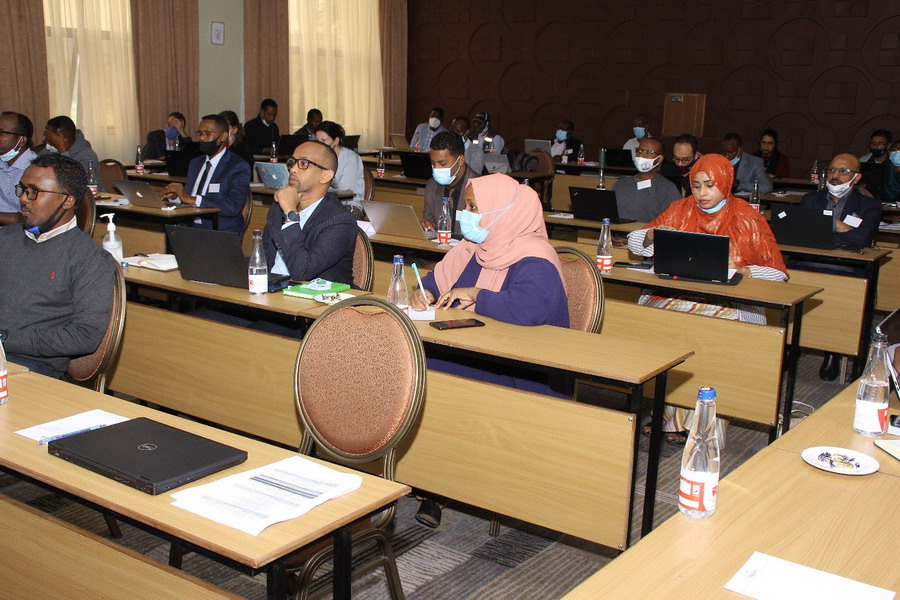 The IDSRS workshop provided a platform for key partners to join together to establish a functional and extensive disease surveillance system in Somalia
The IDSRS workshop provided a platform for key partners to join together to establish a functional and extensive disease surveillance system in Somalia


